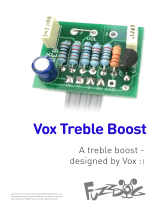Page is loading ...

Little Pecker
A modern take on the
Vox Repeat Percussion
Contents of this document are ©2022 Pedal Parts Ltd.
No reproduction permitted without the express written
permission of Pedal Parts Ltd. All rights reserved.

Important notes
If you’re using any of our footswitch daughterboards,
DOWNLOAD THE DAUGHTERBOARD DOCUMENT
•Download and read the appropriate build document for the daughterboard
as well as this one BEFORE you start.
•DONOT solder the supplied Current Limiting Resistor (CLR) to the main
circuit board even if there is a place for it. This should be soldered to the
footswitch daughterboard.
POWER SUPPLY
Unless otherwise stated in this document this circuit is designed to be
powered with 9V DC.
COMPONENT SPECS
Unless otherwise stated in this document:
•Resistors should be 0.25W. You can use those with higher ratings but
check the physical size of them.
•Electrolytics caps should be at least 25V for 9V circuits, 35V for 18V
circuits. Again, check physical size if using higher ratings.
LAYOUT CONVENTIONS
Unless otherwise stated in this document, the following are used:
•Electrolytic capacitors:
Long leg (anode) to square pad.
•Diodes/LEDs:
Striped leg (cathode) to square pad. Short leg to square pad for LEDs.
•ICs:
Square pad indicates pin 1.

Schematic + BOM
R1 47K
R2 2K2
R3 1M
R4 47K
R5 220K
R6 22K
R7 12K
R8 27K
R9 470R
R10 2K2
R11 470R
C1 220n
C2 10u elec
C3 2u2 elec
C4 100u elec
C5 4u7 elec
C6 2u2 elec
C7 100u elec
C8 1u elec
C9 1u elec
C10 1u
D1 1N4001
Q1 PF5102*
Q2 2N5089
Q3 2N6027
DEPTH 10KB
VOL 100KB
RATE 100KB
T1 220R**
S1 SPDT ONOFFON
*Other FETs may work but we’ve only tested with this one.
**You can use a bigger value but it’ll make your adjustment less precise unless
you’re using a multi-turn trimmer.


PCB layout ©2022 Pedal Parts Ltd.
The power and signal pads match up to the
pads on our Direct Connect daughterboards.
Be very careful when soldering the diode and
transistors. They’re very sensitive to heat. You
should use some kind of heat sink (crocodile clip
or reverse action tweezers) on each leg as you
solder them. Keep exposure to heat to a
minimum (under 2 seconds).
Snap the small metal tag off the pots so they can
be mounted flush in the box.
You should solder all other board-mounted
components before you solder the pots. Once
they’re in place you’ll have no access to much of
the board. Make sure your pots all line up nicely.
Adjust T1 until you get maximum effect without
an audible tick. This is a fixed 100R resistor in
the original, so somewhere around half way on
the trimmer should be sweet.
You can alter the circuit to a two-position toggle
with only two different speed ranges if you
prefer. Use an ON-ON switch and omit C9.

Test the board!
Check the relevant daughterboard document for more
info before you undertake this stage.
UNDER NO CIRCUMSTANCES will troubleshooting help
be offered if you have skipped this stage. No exceptions.
Once you’ve finished the circuit it makes sense to test is before starting on the switch and LED
wiring. It’ll cut down troubleshooting time in the long run. If the circuit works at this stage, but it
doesn’t once you wire up the switch - guess what? You’ve probably made a mistake with the switch.
Solder some nice, long lengths of wire to the board connections for 9V, GND, IN and OUT. Connect
IN and OUT to the jacks as shown. Connect all the GNDs together (twist them up and add a small
amount of solder to tack it). Connect the battery + lead to the 9V wire, same method. Plug in. Go!
If you’re using a ribbon cable you can tack the wires to the ends of that. It’s a lot easier to take them
off there than it is do desolder wires from the PCB pads.
If it works, carry on and do your switch wiring. If not... aw man. At least you know the problem is
with the circuit. Find out why, get it working, THEN worry about the switch etc.
Your completed circuit board
including pots

Wiring shown above will disconnect the battery when you remove the jack plug
from the input, and also when a DC plug is inserted.
The Board GND connections don’t all have to directly attach to the board. You
can run a couple of wires from the DC connector, one to the board, another to
the IN jack, then daisy chain that over to the OUT jack.
It doesn’t matter how they all connect, as long as they do.
This circuit is standard, Negative GND. Your power supply should be Tip
Negative / Sleeve Positive. That’s the same as your standard pedals (Boss etc),
and you can safely daisy-chain your supply to this pedal.
L
E
D
BOARD
OUT
BOARD
9V
BOARD
GND
BOARD
GND
BOARD
GND
BOARD
INPUT
BATTERY
+
IN
OUT
L
E
D
BOARD
GND
BOARD
9V
+
Wire it up (if using a daughterboard please refer to the relevant document)

This template is a rough guide only. You should ensure correct marking of your
enclosure before drilling. You use this template at your own risk.
Pedal Parts Ltd can accept no responsibility for incorrect drilling of enclosures.
FuzzDog.co.uk
Drilling template
Hammond 1590B
60 x 111 x 31mm
It’s a good idea to drill the pot and
toggle switch holes 1mm bigger if
you’re board-mounting them.
Wiggle room = good!
Recommended drill sizes:
Pots 7mm
Jacks 10mm
Footswitch 12mm
DC Socket 12mm
Toggle Switches 6mm
4mm
21mm
32mm
/









